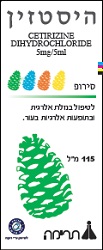Quest for the right Drug

היסטזין HISTAZINE (CETIRIZINE DIHYDROCHLORIDE)
תרופה במרשם
תרופה בסל
נרקוטיקה
ציטוטוקסיקה
צורת מתן:
פומי : PER OS
צורת מינון:
סירופ : SYRUP
עלון לרופא
מינוניםPosology התוויות
Indications תופעות לוואי
Adverse reactions התוויות נגד
Contraindications אינטראקציות
Interactions מינון יתר
Overdose הריון/הנקה
Pregnancy & Lactation אוכלוסיות מיוחדות
Special populations תכונות פרמקולוגיות
Pharmacological properties מידע רוקחי
Pharmaceutical particulars אזהרת שימוש
Special Warning עלון לרופא
Physicians Leaflet
Pharmacological properties : תכונות פרמקולוגיות
Pharmacodynamic Properties
5.1 Pharmacodynamic properties Pharmacotherapeutic group: Antihistamine for systemic use, piperazine derivatives, ATC code: R06A E07 Mechanism of action Cetirizine, a human metabolite of hydroxyzine, is a potent and selective antagonist of peripheral H1- receptors. In vitro receptor binding studies have shown no measurable affinity for other than H1-receptors. Pharmacodynamic effects In addition to its anti-H1 effect, cetirizine was shown to display anti-allergic activities: at a dose of 10 mg once or twice daily, it inhibits the late phase recruitment of eosinophils, in the skin and conjunctiva of atopic subjects submitted to allergen challenge. Clinical efficacy and safety Studies in healthy volunteers show that cetirizine, at doses of 5 and 10 mg strongly inhibits the wheal and flare reactions induced by very high concentrations of histamine into the skin, but the correlation with efficacy is not established. In a six-week, placebo-controlled study of 186 patients with allergic rhinitis and concomitant mild to moderate asthma, cetirizine 10 mg once daily improved rhinitis symptoms and did not alter pulmonary function. This study supports the safety of administering cetirizine to allergic patients with mild to moderate asthma. In a placebo-controlled study, cetirizine given at the high daily dose of 60 mg for seven days did not cause statistically significant prolongation of QT interval. At the recommended dosage, cetirizine has demonstrated that it improves the quality of life of patients with perennial and seasonal allergic rhinitis. Paediatric population In a 35-day study in children aged 5 to 12, no tolerance to the antihistaminic effect (suppression of wheal and flare) of cetirizine was found. When a treatment with cetirizine is stopped after repeated administration, the skin recovers its normal reactivity to histamine within 3 days.
Pharmacokinetic Properties
5.2 Pharmacokinetic properties Absorption The steady - state peak plasma concentrations is approximately 300 ng/ml and is achieved within 1.0 ± 0.5 h.. The distribution of pharmacokinetic parameters such as peak plasma concentration (Cmax) and area under curve (AUC) is unimodal. The extent of absorption of cetirizine is not reduced with food, although the rate of absorption is decreased. The extent of bioavailability is similar when cetirizine is given as solutions, capsules or tablets. Distribution The apparent volume of distribution is 0.50 l/kg. Plasma protein binding of cetirizine is 93 ± 0.3 %. Cetirizine does not modify the protein binding of warfarin. Biotransformation Cetirizine does not undergo extensive first pass metabolism. Elimination The terminal half-life is approximately 10 hours and no accumulation is observed for cetirizine following daily doses of 10 mg for 10 days. About two third of the dose are excreted unchanged in urine. Linearity/Non-linearity Cetirizine exhibits linear kinetics over the range of 5 to 60 mg. Renal impairment: The pharmacokinetics of the drug was similar in patients with mild impairment (creatinine clearance higher than 40 ml/min) and healthy volunteers. Patients with moderate renal impairment had a 3-fold increase in half-life and 70 % decrease in clearance compared to healthy volunteers. Patients on hemodialysis (creatinine clearance less than 7 ml/min) given a single oral 10 mg dose of cetirizine had a 3- fold increase in half-life and a 70 % decrease in clearance compared to normals. Cetirizine was poorly cleared by haemodialysis. Dosing adjustment is necessary in patients with moderate or severe renal impairment (see section 4.2). Hepatic impairment: Patients with chronic liver diseases (hepatocellular, cholestatic, and biliary cirrhosis) given 10 or 20 mg of cetirizine as a single dose had a 50 % increase in half-life along with a 40 % decrease in clearance compared to healthy subjects. Dosing adjustment is only necessary in patients with hepatic impairment if concomitant renal impairment is present. Elderly: Following a single 10 mg oral dose, half-life increased by about 50 % and clearance decreased by 40 % in 16 elderly subjects compared to the normal subjects. The decrease in cetirizine clearance in these elderly volunteers appeared to be related to their decreased renal function. Paediatric population: The half-life of cetirizine was about 6 hours in children of 6-12 years and 5 hours in children 2-6 years. In infants and toddlers aged 6 to 24 months, it is reduced to 3.1 hours.

מסגרת הכללה בסל
התוויות הכלולות במסגרת הסל
| התוויה | תאריך הכללה | תחום קליני | Class Effect | מצב מחלה |
|---|---|---|---|---|
| MIZOLASTINE | ||||
| CETIRIZINE | ||||
| EBASTINE | ||||
| FEXOFENADINE | ||||
| LEVOCABASTINE | ||||
| LORATADINE | ||||
| MIZOLASTINE |
שימוש לפי פנקס קופ''ח כללית 1994
לא צוין
תאריך הכללה מקורי בסל
01/01/2000
הגבלות
לא צוין
רישום
109 59 29304 00
מחיר
0 ₪
מידע נוסף
